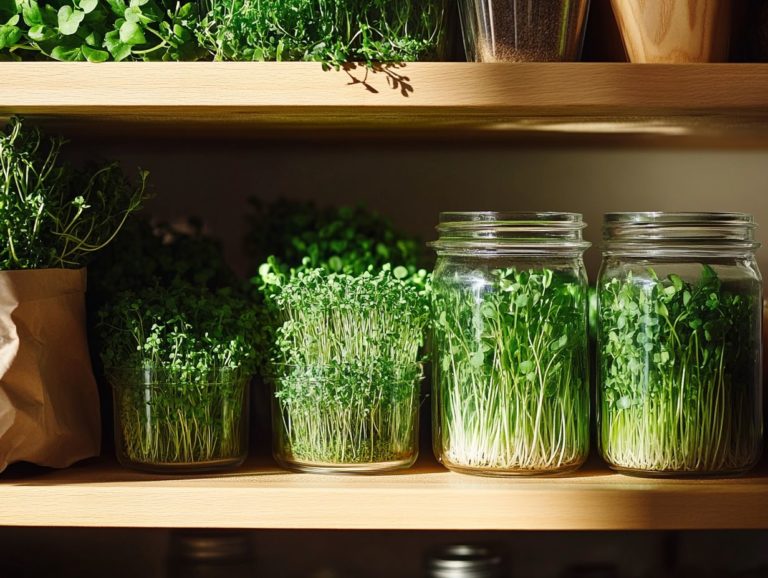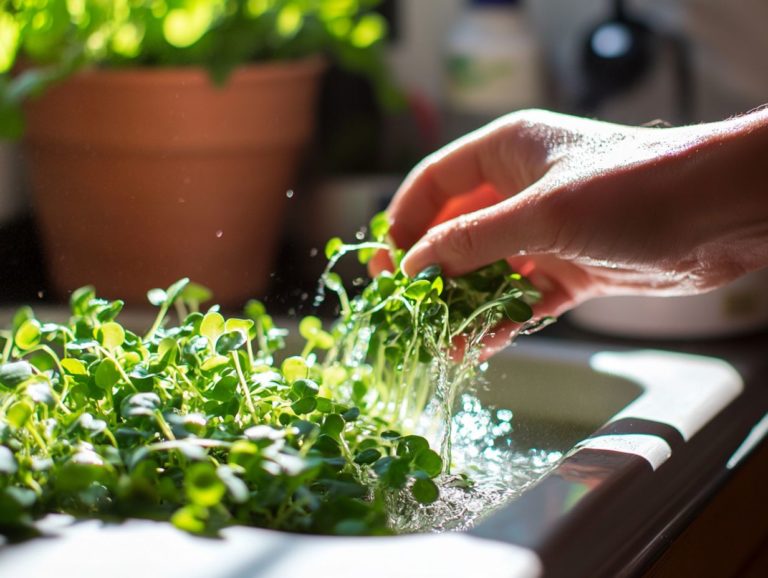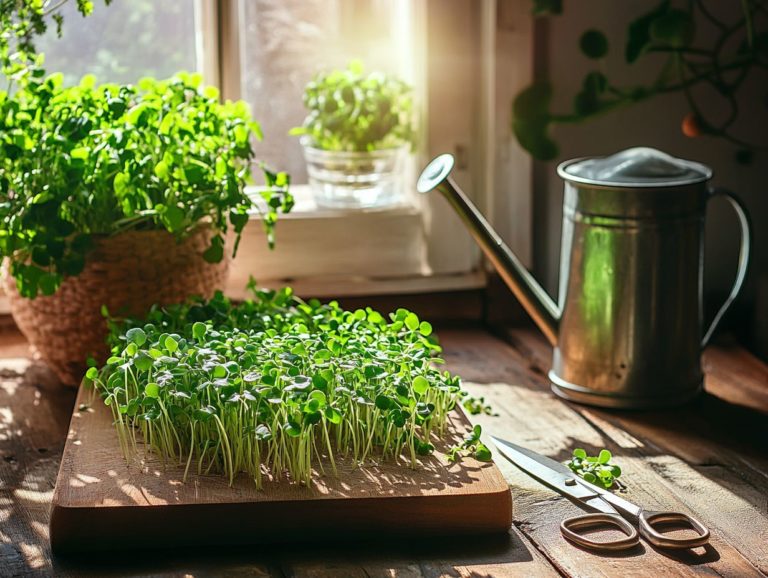5 Common Microgreen Storage Mistakes to Avoid
Microgreens are a nutritional powerhouse, brimming with flavor and health benefits. However, if you don’t store them properly, these vibrant greens can quickly lose their freshness and quality.
This piece outlines five common mistakes to avoid when storing microgreens. By doing so, you’ll maximize the value of your harvest.
You’ll also discover the best storage techniques and learn how to recognize when your microgreens have gone bad. Explore creative ways to incorporate them into your meals!
Dive in to master the art of keeping your microgreens at their best!
Contents
- Key Takeaways:
- 1. Storing Microgreens in the Wrong Temperature
- 2. Not Using the Proper Containers
- 3. Not Washing and Drying Microgreens Before Storage
- 4. Storing Microgreens with Other Fruits and Vegetables
- 5. Not Rotating Microgreens Regularly
- How Long Can Microgreens Be Stored?
- Frequently Asked Questions
- What are the common mistakes to avoid when storing microgreens?
- Why shouldn’t I leave microgreens in their original packaging?
- How does exposure to moisture affect microgreens?
- What is the recommended temperature for storing microgreens?
- How long can I store microgreens for?
- Can I freeze microgreens for long-term storage?
Key Takeaways:

- Maintain proper temperature to extend shelf life.
- Use airtight bags or containers to prevent moisture buildup.
- Wash and dry microgreens before storage to prevent bacteria and mold growth.
1. Storing Microgreens in the Wrong Temperature
Storing microgreens at the wrong temperature can drastically shorten their shelf life and compromise their nutritional value. This ultimately leads to increased food waste and a loss of the vibrant flavors you expect from these nutrient-packed plants.
Understanding the ideal storage temperature is essential for preserving the quality of microgreens like broccoli, kale, and arugula. Microgreens typically thrive best in temperatures ranging from 32 F to 40 F.
When exposed to higher temperatures, gas that speeds up ripening increases, leading to spoilage. Conversely, lower temperatures disrupt moisture balance, resulting in wilting and other common problems.
To achieve optimal freshness, store them in containers that allow air to flow. Use a humidity monitor to keep an eye on moisture levels both inside and out. Regularly checking these factors ensures your microgreens remain crisp and vibrant.
2. Not Using the Proper Containers
Using the wrong containers for microgreens can cause several problems. These include moisture buildup, bacteria growth, and loss of flavor, all of which reduce their quality and shelf life.
Selecting the right container is pivotal for preserving these delicate plants and fostering ideal environmental conditions. While plastic containers may offer a lightweight solution, ensure they are designed for ventilation to prevent excess moisture buildup.
Eco-friendly options like biodegradable trays and paper bags are becoming popular among consumers who care about the environment.
Gentle handling during storage is crucial since microgreens are sensitive to pressure and over-manipulation. Maintaining balanced moisture levels will help these vibrant greens retain their rich colors and crisp textures, ensuring they stay fresh and flavorful for an extended period. For more insights, consider the 5 key factors for successful microgreen growing.
3. Not Washing and Drying Microgreens Before Storage
Failing to wash and dry microgreens before storage can significantly impact their shelf life and nutritional value. Excess moisture can create a perfect environment for condensation, bacteria growth, and spoilage, leading to common problems.
To mitigate these risks, you need to employ effective washing techniques that thoroughly remove any soil and potential pesticide residues. Begin by rinsing the microgreens gently under cool, running water. This method removes dirt without bruising the microgreens.
A salad spinner can be an invaluable tool in this process, as it assists in both washing and drying, especially when considering bottom watering techniques.
After rinsing, ensure that you dry them thoroughly. This step not only prevents moisture-related issues during storage but also helps maintain their crispness.
To manage condensation control while storing, consider using breathable containers or lining them with paper towels to absorb any residual moisture. This careful attention ensures that your microgreens remain fresh and nutritious for an extended period.
4. Storing Microgreens with Other Fruits and Vegetables
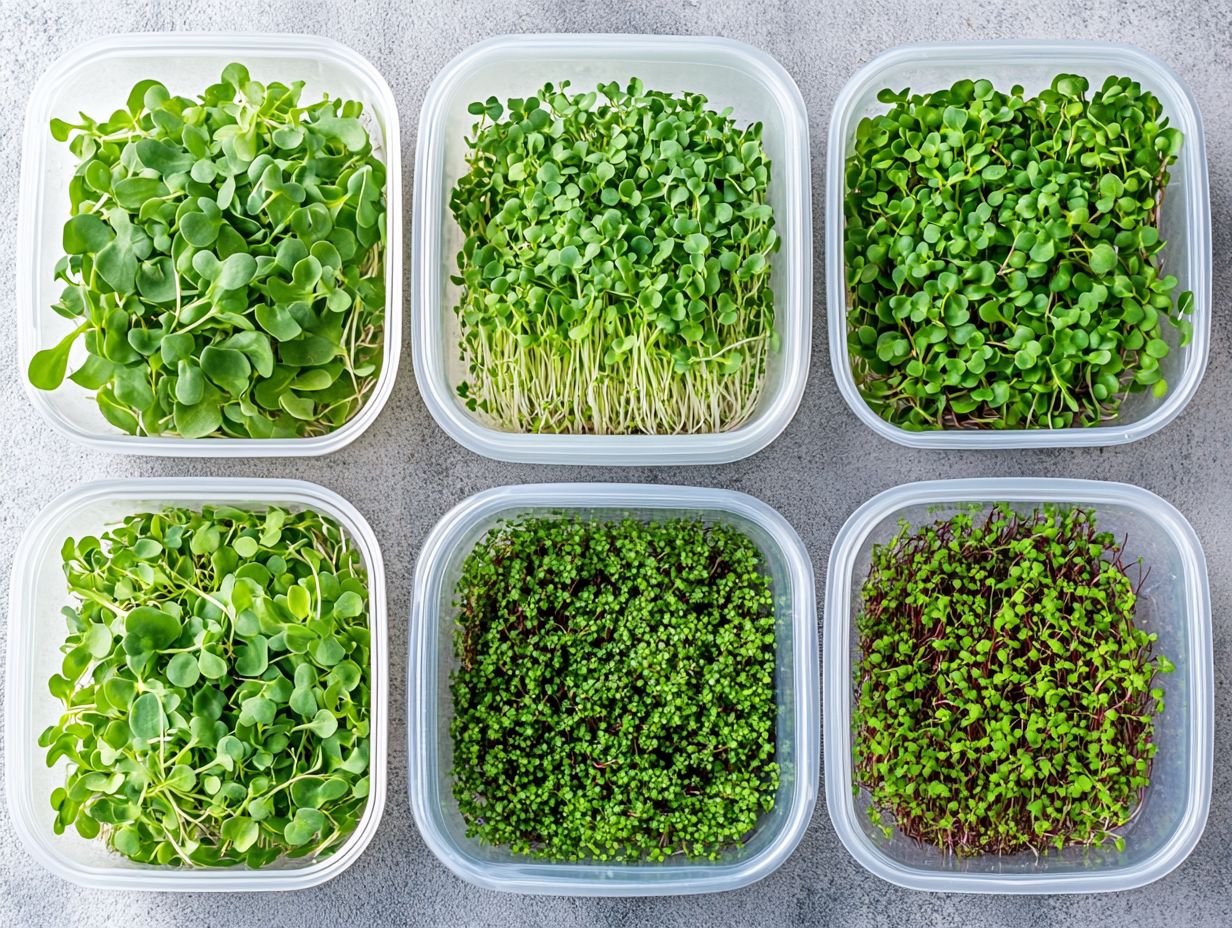
Storing microgreens alongside fruits and vegetables that emit ethylene gas a natural gas that some fruits and vegetables release, affecting ripening can significantly shorten their shelf life and compromise their flavor. This ultimately leads to increased food waste and reduced nutrient retention.
Certain fruits, like bananas, avocados, and apples, along with vegetables such as tomatoes and potatoes, are known for releasing this gas, which hastens ripening and degradation.
To preserve their freshness, you must keep these delicate greens away from ethylene-producing items. Focus on maintaining optimal oxygen levels within their storage environment.
Try designating crisper drawers solely for microgreens. Line them with paper towels to soak up excess moisture, ensuring internal moisture levels remain balanced.
Utilizing separate storage containers and ensuring that any utensils or surfaces are thoroughly washed can be effective tactics to prevent flavor cross-contamination. This preserves quality and extends the life of these vibrant greens.
5. Not Rotating Microgreens Regularly
Don’t let your microgreens go bad! Rotate them regularly to keep them fresh and nutritious. Neglecting to do so can lead to spoilage and nutrient degradation.
Practicing rotation not only keeps your microgreens fresh but also enhances their nutrient retention and flavor. Consider organizing your storage by labeling containers with the harvest date; this allows for easy tracking of freshness.
Monitoring the condition of your microgreens is crucial. Regularly inspecting them for any signs of wilting or discoloration can help you catch spoilage early. A thoughtful approach to refreshing your stock like placing newer batches behind the older ones will uphold quality and ensure your microgreens remain vibrant and visually appealing.
This is especially important for culinary use or aesthetic presentation, particularly in urban farms.
What are your tips for storing microgreens? Share your experiences and help others keep their greens fresh!
How Long Can Microgreens Be Stored?
The shelf life of microgreens can vary quite a bit, influenced by factors such as variety, storage conditions, and handling practices. Understanding how to maximize their longevity is essential for anyone looking to enjoy these nutrient-packed greens.
For example, varieties like pea shoots and sunflower microgreens usually last around 7 to 14 days when stored properly. In contrast, radish and arugula microgreens might only last about 5 to 10 days. Environmental factors such as temperature and humidity significantly impact how long these delicate greens stay fresh and edible.
To extend their freshness, store microgreens in a cool, dark place ideally in a sealed container lined with a damp paper towel. This helps maintain the right moisture levels and prevents wilting. Proper handling during harvesting and transportation is equally vital; avoiding bruising will help preserve their crisp texture and vibrant flavor. Additionally, being aware of the top 5 mistakes in growing microgreens can further enhance your experience.
What Are the Best Ways to Store Microgreens?
The best ways to store microgreens hinge on effective techniques that balance moisture and optimize air flow.
By selecting airtight containers, you can minimize the effects of ethylene, a natural gas that can cause fruits and vegetables to ripen too quickly. Line your containers with paper towels to absorb excess moisture, a crucial step in preventing spoilage.
Using perforated lids allows fresh air to circulate freely, further reducing conditions that promote deterioration and enhancing microgreen preservation.
By grasping these straightforward practices, you can create the perfect environment for storage, extending the shelf life of your microgreens while preserving their rich nutrients and delightful taste.
What Are the Nutritional Benefits of Microgreens?
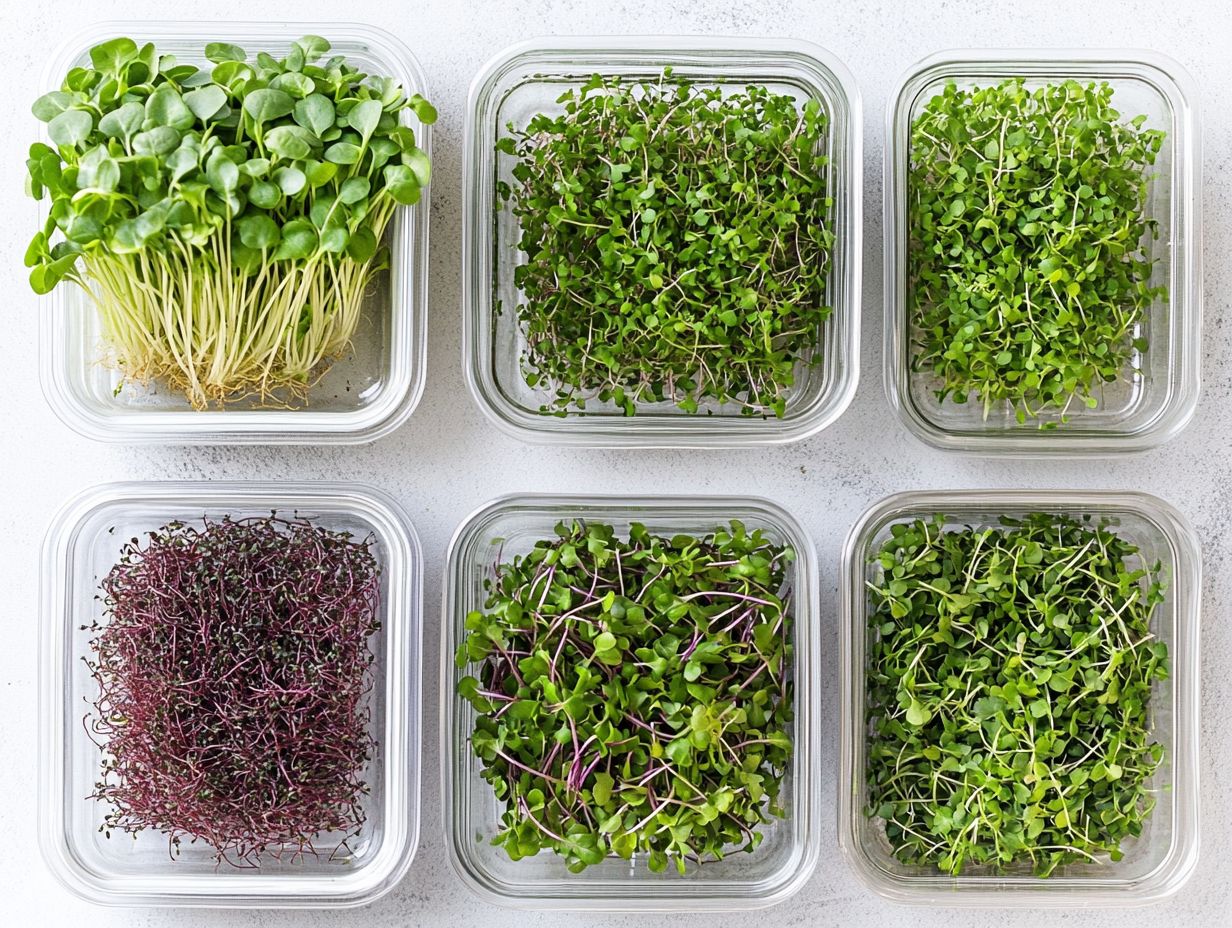
Microgreens offer an exceptional nutritional profile, brimming with vitamins, minerals, and antioxidants. Incorporating them into your diet enhances your health while helping to reduce food waste through their remarkably efficient growth.
Among the vast array of options, kale microgreens shine with their abundant vitamins A, C, and K, supporting immune function and bone health. Broccoli microgreens are also noteworthy for their sulforaphane content, celebrated for its potential cancer-fighting properties.
Pea shoots are vibrant and visually appealing; they also pack a punch with a high level of protein and essential amino acids, key to muscle health and overall vitality. You can boost your meals by knowing how to keep nutrients in your microgreens!
Can Microgreens Be Frozen?
Freezing microgreens is a fantastic way to keep their delicious flavors for later! Use the right techniques to maintain moisture balance and preserve their quality and flavor.
First, wash the microgreens thoroughly with cold water to eliminate dirt or contaminants. After rinsing, gently dry them using a salad spinner or clean kitchen towels; this step is crucial to remove excess moisture that could lead to freezer burn.
Next, package them in airtight containers or resealable freezer bags, removing as much air as possible to protect against oxidation. This careful handling retains nutrients and keeps flavors intact when thawed, making them a delightful addition to your dishes even months down the line.
Start storing your microgreens today and enjoy their amazing benefits!
How Can One Tell If Microgreens Have Gone Bad?
How can you tell if your microgreens have gone bad? Watch out for discoloration, wilting, and unpleasant odors. These signs mean your greens have lost their freshness and health benefits.
Recognizing these issues is crucial for anyone looking to maintain the quality of their microgreens. Not only do they impact taste, but they also diminish the health benefits these nutrient-packed plants provide.
To extend their shelf life, proper storage is essential. Keep your microgreens in a cool, dry place, ideally in a breathable container that allows airflow while shielding them from moisture.
Make sure to check regularly for any signs of spoilage. This will help you avoid the unfortunate experience of using spoiled greens.
What Are Some Creative Ways to Use Stored Microgreens?
Stored microgreens offer a world of creative possibilities. You can enhance your dishes with their delicate flavors and impressive nutritional benefits, all while highlighting the diverse types available.
Imagine elevating your salads with these tiny powerhouses; they provide a refreshing crunch and vibrant color that transforms the overall presentation.
When blended into smoothies, microgreens become a perfect canvas for unique flavor profiles. They contribute both nutrition and a subtle earthiness that enriches each sip.
Garnish your dishes with microgreens to instantly elevate their visual appeal and taste! Their versatility ensures that each meal celebrates the distinctive flavors of microgreens, creating a truly memorable dining experience.
Frequently Asked Questions
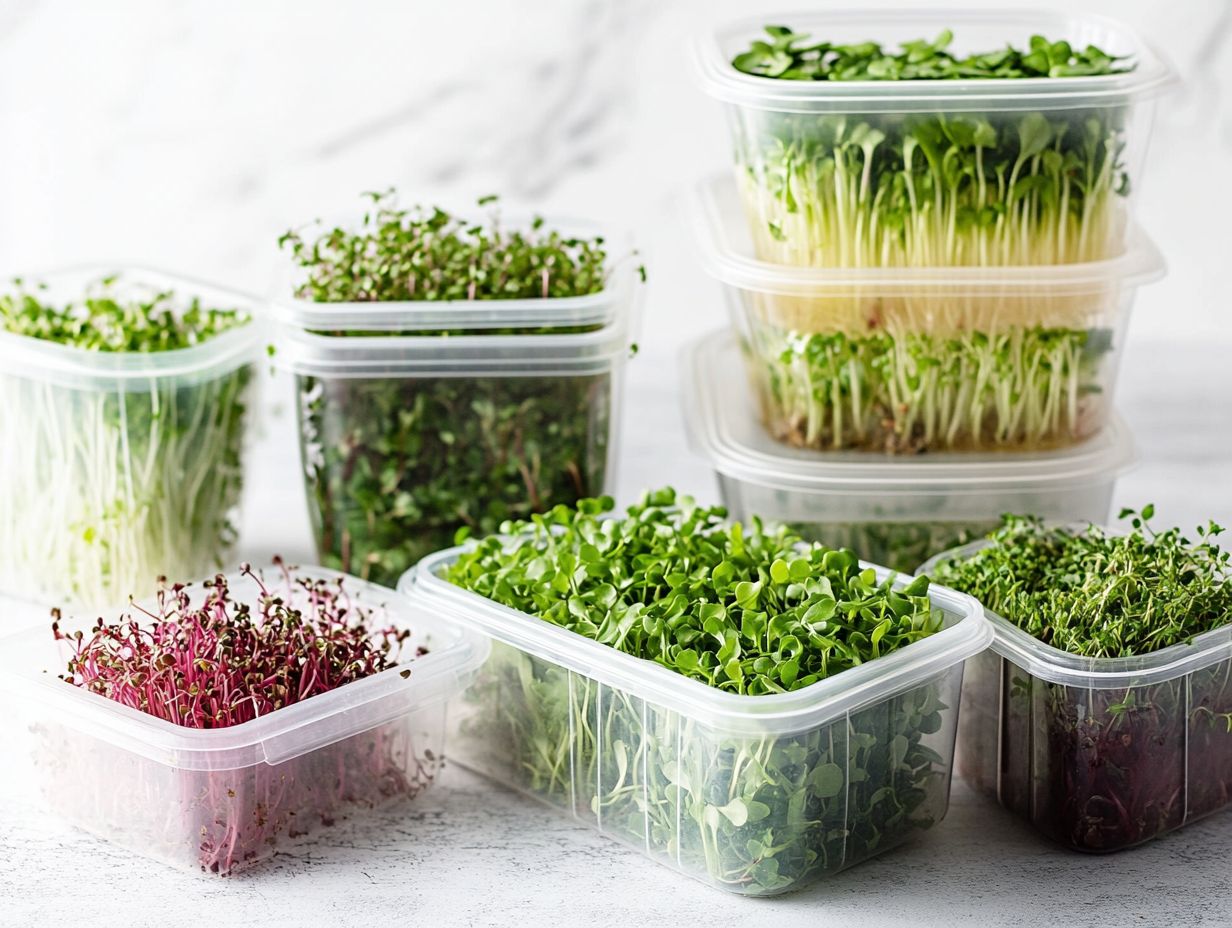
What are the common mistakes to avoid when storing microgreens?
Some common mistakes to avoid include:
- Leaving microgreens in their original packaging
- Not storing them in an airtight container
- Exposing them to moisture
- Storing them at the wrong temperature
- Not using them within the recommended time frame
Why shouldn’t I leave microgreens in their original packaging?
Microgreens are usually sold in plastic clamshells or bags, which are not ideal for long-term storage. They can limit airflow and cause moisture buildup, leading to mold growth. It’s best to transfer them to an airtight container for storage.
How does exposure to moisture affect microgreens?
Microgreens are delicate and can easily wilt or become soggy when exposed to moisture. This can also cause mold growth. Remove any excess moisture from the microgreens before storing them to avoid this issue.
What is the recommended temperature for storing microgreens?
Microgreens are best stored in a cool, dry place, ideally between 35-40 F (1-4 C). Storing them at higher temperatures can cause them to wilt and lose their freshness quickly.
How long can I store microgreens for?
Microgreens are best used within 5-7 days of purchase, as they lose their nutritional value and taste over time. For the freshest taste and highest nutritional content, consume them as soon as possible.
Can I freeze microgreens for long-term storage?
While freezing microgreens is possible, it is not recommended as it can alter their texture and flavor. It’s best to consume them fresh or store them in the fridge for short-term storage.

